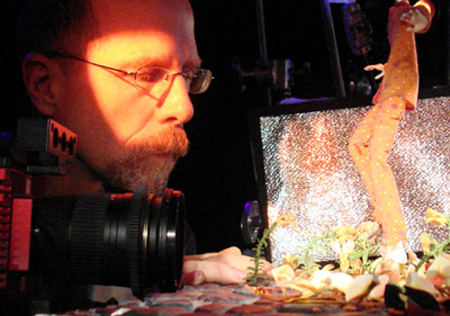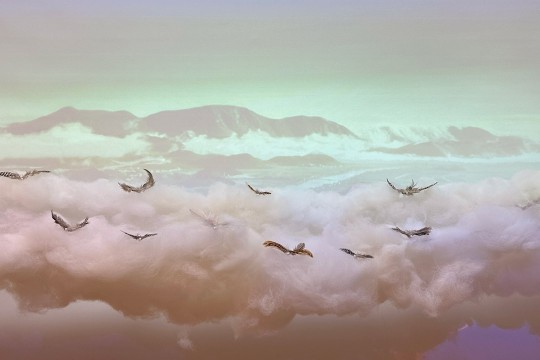RIT animators part of team that worked on Coraline film
Stop-motion animated feature opens in theatres Feb. 6
Tom Gasek
RIT professor Tom Gasek animates Coraline's body as she jumps up from being bit by snap dragon flowers. The digital camera is frame left and the puppet of Coraline is frame right with a reflector board behind her.
The adventures of a little girl come to life on the big screen as the stop-motion animated feature film, Coraline, opens nationwide today in theatres. Viewers will witness the work of RIT professor and character animator Tom Gasek ’79 (design), stop-motion animator Teresa Drilling ’83 (art and design) and master of fine arts student Adam Fisher.
Gasek, an assistant professor in RIT’s School of Film and Animation, spent four weeks last summer working on the film. Directed by Henry Selick, the director of Nightmare Before Christmas, Coraline is the story of a little girl who stumbles upon a passageway in her home where she discovers an eerie fantasy world, known as the “Other World.”
The Other World is where you’ll see Gasek’s creative talents. Called upon as an additional animator for the film, he worked on some of the quicker action shots like animating the snapdragons that attack Coraline’s feet or animating Coraline as she jumps out of the way, in horror, from the claw of a preying mantis.
Gasek says some of the top stop-motion animators in the industry collaborated on Coraline. Many of them Gasek has known for years, having worked with them in the ’80s and ’90s during his career at studios like Will Vinton Productions and Aardman Animations. RIT alumna Teresa Drilling is one of the film’s animators. Fans have seen Drilling’s work previously in the hit feature films like Wallace & Gromit: The Curse of the Were-Rabbit and Chicken Run.
“It was very impressive,” says Gasek. “The stop-motion animators on Coraline were the best of the best. It was a little intimidating at first, but I rose to the occasion and really enjoyed the work.”
Stop-motion animation is a labor-intensive process: the animator poses the model, shoots a frame, changes the pose, shoots the next frame, and on and on.
Coraline is produced by Laika, an animation studio based out of Portland, Ore. It’s the first stop-motion animation feature film to be shot in stereoscopic 3-D.
“Stereoscopic 3-D gives the film the kind of effect you would see looking through a toy Viewmaster,” says Gasek. “During filming, each camera had a motion control machine, which controls the camera point of view, so you get a shot from a left and right angle creating the 3-D effect.”
Gasek says a 10-second frame could take up to three weeks to animate.
The story is darker than others that Gasek has worked on. Coraline, written by Neil Gaiman with the screenplay of Henry Selick, draws inspiration from some Eastern European stories that reflect a certain macabre sensibility.
“Henry Selick is concerned with craft and the way the animation is executed,” adds Gasek. “He has a keen sense of the characters. It’s a spooky story, but the film has a good message to it that applies to all cultures. I’m interested to see how American audiences respond to it.”
Gasek’s other film credits include the Oscar-winning Wallace and Gromit film, The Wrong Trousers and Chicken Run. Gasek also directed and animated the Penny Cartoon for the CBS Show, Pee Wee’s Playhouse. He is currently completing his own independent animated short, Off-Line.
Adam Fisher, a master of fine arts graduate student in the School of Film and Animation, contributed to the pre-visualization of the lip sync on the Coraline characters, essentially helping to make sure their mouths looked correct when they spoke.
RIT’s School of Film and Animation has been developing a strong relationship with Laika as a potential employer for its graduates.
To see the movie trailer for Coraline, visit the Laika website.















